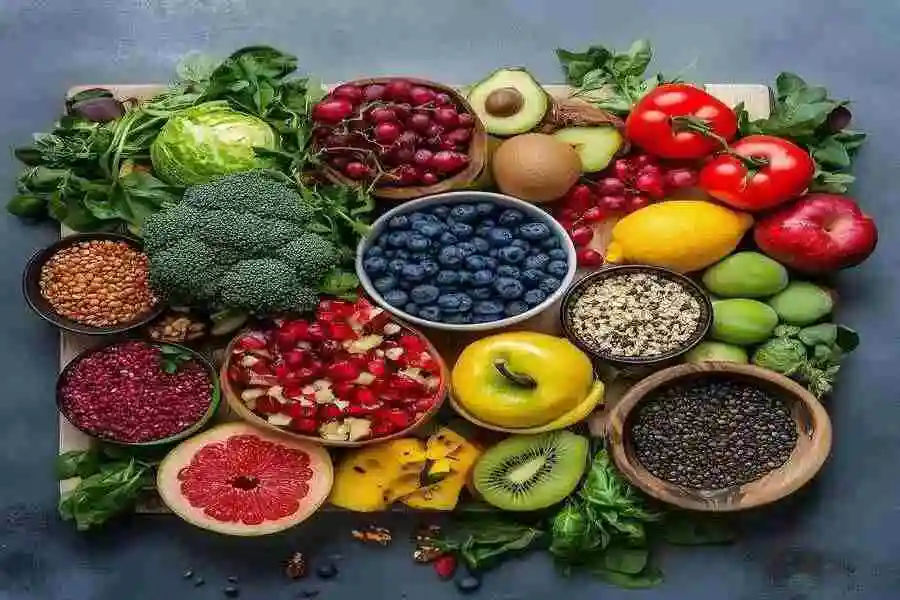In this article. we will discuss the following topics regarding the balanced diet for kids:
- Importance of a healthy and balanced diet in childhood
- Understanding the nutrition needs of children by age groups
- How to handle the picky eating habits of children?
- Strategies to encourage your child to try new foods
- Balancing healthy eating with occasional indulgences
- Some superfoods for growing kids
- Seasonal fruits and vegetables to boost immunity
- Meal planning tips for busy parents for a well balanced diet
- Including the kids in the meal-prep process
- Encourage healthy eating habits in your kids
- Introduce reward systems that promote healthy food choices.
The food we eat has a direct impact on our life when we talk about its physical and mental aspects. Although the food is required for everyone, whether young or old and the quantity depends upon the age of the individual, utmost care should be taken about the balanced diet for young children. Here, the quality is as important as the frequency along with the appropriate quantity of food, since the tender age demands it. Here, we throw some light on children’s healthy and balanced diet tips which can come very handy for the parents.
1. Importance of a healthy and balanced diet in Childhood
During the first five years of life, the quality of the food determines the health of the bone growth and the brain development of the child. Therefore, taking balanced diet which is nutrient-rich too, is extremely important during the childhood days in the life of a person.
a) Foundation for a Healthy Life
The kind of food that a child takes in the early years of its growth, determines the health of the child in the later years. We can say that the nutritient rich food given to the baby in the first five years paves the way for better health in the future. Some of the benefits of providing a balanced diet to your kid are
Physical Growth: The child’s body growth is maximum in the early years and being fed with proper nutrient rich food, sensures a healthy bone growth and good muscle development of the growing child.
Brain Development: Taking a balanced diet with the essential nutrients like omega-3 fatty acids, iron, and vitamins helps in the overall cognitive development of the brain of the growing baby.
Immunity building: A diet full of nutrition makes the immune system strong, besides reducing the risk of frequent illnesses like common colds and infections in the growing baby. Meeting daily requirements of the body in the shape.
b) The role of macronutrients (carbs, proteins, fats) in the balanced diet
The body cannot sustain itself without food for many days, but equally important is the role of nutritious food at that. The carbohydrates, proteins ans the fats which arte combinely called ‘macronutreints’, are the especially important foods for the balanced diet of the child in the early years. These meet all the requirements of the child’s body while growing, which ensures the healthy growth. These can be explained as

Carbohydrates
All fibres, whether starches and sugars, are constituents of carbohydrates. These carbohydrates are converted by the human body into sugars which provide the energy we need to function properly. Therefore, these carbohydrates need to be included in your kid’s diet. Make sure that your child eats whole grains like wheat, brown rice, and millets instead of refined options.
Proteins
Proteins are essential for building muscles and repairing worn out tissues of the body. Include dals, eggs, paneer, and lean meat in their diet of your child so that the aim of providing a healthy and balanced diet to the child is achieved.
Fats
Healthy fats are also important for the proper growth of the body, You must include nuts, seeds, and ghee, which help in the brain development and energy storage. amd
c) The role of micronutrients (vitamins, minerals) in balanced diet.

The micronutrients, which consist of Vitamins and Minerals, are needed by the body for proper functioning. Even though they are not the primary sources of energy, their involvement is essential in the metabolic processes, which ensures that our body gets energy from the fats, carbohydrates and the proteins. Any depletion of these can result in the immune deficiency in the body and other complications in the child. Some of the important micronutrients which constitute a balanced diet are
- Calcium for strong bones (milk, yogurt, spinach).
- Iron for preventing anemia (jaggery, beans, green leafy vegetables).
- Vitamin C for boosting immunity (oranges, guavas, amla).
2. Understanding the nutrition needs of children by age groups
We must ensure the right quantity, quality and frequency of food that you give the child in order to fulfill the Healthy Diet Balance criterion. There are stages of growth of a child and providing the right food at this stage is essential. As a parent, you are the best person who understands the needs of the child and sticking to the schedule will prove beneficial towards achieve the balanced diet plan. Some of the nutritional needs of the child at different ages are
i) Infants (0-6 Months)
Exclusive Breastfeeding is required at this stage since the mother’s milk provides all the essential nutrients and hydration to the baby, besides producing the antibodies for fighting the infections. The feeding schedule needs to be set up for the baby and essentially the frequency of breastfeeding should be after every 2-3 hours or as required by the baby.
For some of the mothers who can’t breastfeed the baby due to any condition or situation, the formula milk should be fed to the baby till the mother reaches the stage where she can feed the baby herself.
ii) Weaning Phase (6-12 Months): Gradual Introduction of Solids
At this stage, the baby can be fed the mashed fruits like the banana or the apple. In vegetables, some boiled or pureed vegetables like carrots and pumpkin should be given. The baby can also be fed some cereals like ragi or rice, which are also a rich source of iron, calcium, potassium and magnesium which adds to the balanced diet.
You can start with the purees and then gradually move towards mashed food or the soft and small portions. Ideally, you should introduce one food at a time to test for any allergy towards any food. You must avoid salt, sugar and honey till the baby completes one year.
iii) Toddlers (1-3 Years): Establishing Eating Habits
This stage requires you to introduce your child to more solid foods for bone growth and brain development. You can introduce milk and milk products for calcium and fish or walnuts for the omega-3 fatty acids for the brain development.
You can feed these to the baby frequently in small portions. To make it more fun for the kid, offer colorful plates with mixed textures and encourage your child to self-feed.
iv) Preschoolers (4-6 Years): Building a Routine
For the preschoolers, building a routine is a must. Here, you must ensure 3 meals and 2 healthy snacks every day. Your focus should be on fiber content, so that the baby is not constipated and the ideal foods for this are whole grains, fruits and vegetables. Try to reduce the junk food, such as sugary snacks, processed foods and sugar drinks as much as possible.
v) School-Age Children (7-12 Years): Energy and Growth Spurt
School going children have more energy needs as at this stage, as they tend to be more active and indulge in more physical work than ever before. SInce the importance of a balanced diet is more in these years, you can introduce whole grains, fruits, proteins and the dairy-related foods.
Also, nuts should be included in the diet to boost the energy levels. You can give homemade food like roasted makhana, chivda or vegetable sandwiches for the lunch and encourage plain water rather than the packaged juices or soda.
vi) Adolescents (13-18 Years): Coping with Puberty and Increased Demands
This age is very important and at the same time a delicate one as this is just the beginning of your kid’s foray into the adult world. The kid needs more diverse and nutrient-rich food to cope up with the ever-increasing demand of the body for strong body and full growth. You must feed them adequately with the balanced diet and according to the minerals required.
Protein-Rich Diet
This type of diet supports rapid growth and hormonal changes, which take place in your child’s body. Examples are eggs, dals, chicken, soy products, etc.
Iron and Calcium
Both boys and girls need extra calcium in these years for greater bone density. Also, girls at this stage need extra iron due menstruation which takes place at this stage. Examples are spinach, red meat, sea food, beans, green leafy vegetables and the dry fruits.
3. How to handle the picky eating habits of children?
The picky habit for food is a usual phenomenon seen in children in the early ages and is a major hinderance in achieving the balanced diet criteria for a child. It is the result of various issues that happen with small children right from their early stages of growth. Some causes may be the late introduction of the semi-solid foods during weaning, pressurizing the child to eat or the child developing a dislike for certain foods due to their particular smell or being fed the same food continuously.

Deficiency of minerals like iron and zinc, resulting from the low intake of meats, fruits or vegetables, can take place in the later years of the growing child. Also, the deficiency of the dietary fibre which results from the low intake of certain fruits and vegetables can cause constipation in the child. This picky eating can cause many other complications as the essential nutrients in the diet are not found in the child’s food. Other complications include the growth hinderances, both physical and the mental one, which is a just the opposite to what a balanced diet should be.
This may be a result of a special taste developed by your child towards some foods that may or may not be nutritious at all. This often can lead to the deficiency in the body and results in other complications such as slow growth, low grasping power, weak bones, etc. As a parent, you need to see to it that your child develops the taste for every kind of food.
Common Causes of Picky Eating in Children
Fear of Trying New Foods (Neophobia)
Many young children instinctively reject unfamiliar foods or the ones which they may have never tried before—a behavior rooted in evolution to protect against potentially harmful substances, but it goes highly againt the balanced diet approach that we should follow. However, with repeated exposure to these with a positive and careful approach, they can gradually become more accepting of new flavors.
Developmental Phases and Growth Milestones
Picky eating habits have more to do with the growth and the developmental changes in the child. Small children in particular, try to assert their independence by being choosy and rejecting certain foods. However, genuine reasons like the growth spurts and the changing appetites can also contribute to the uncertain food preferences of the child.
Genetic Influence and Taste Preferences
Some children are genetically wired to prefer sweeter or milder flavors while avoiding bitter or spicy foods. These inherited taste preferences can shape their long-term eating habits, even though the parents often get hassled by the child’s unusual behaviors.
4. Strategies to encourage your child to try new foods
You cannot force your child to eat everything you prepare at home. More often, your kid will develop preferences for some food and dislikes for other foods. However, there are some strategies which can help you to solve this issue in order to maintain the balanced diet. Some of them are



Creative Ways to Make Food Appealing
Try to present food to your kid in a fun way, such as cutting fruits and vegetables into shapes or creating colorful plates, which can appeal to your child more. A visually appealing meal can lure kids to consume it, who normally tend to be picky eaters. This will make up for the deficiency which they may encounter due to te absense of the balanced diet.
Gradual Exposure to Unfamiliar Tastes
Introduce new foods alongside familiar favorites. Offer small portions regularly and without pressure, allowing the child to explore at their own pace.
Role Modeling Healthy Eating Behaviors
Children are more likely to try foods they see their parents or siblings enjoying. You should create family meals where everyone eats the same food to set a positive example for your kid.
5. Balancing healthy eating with occasional indulgences
You need to strike a balance between healthy eating habits and allowing other foods that your child has a craving for. This would serve a great way to introduce a balanced diet to your kid. You can employ some techniques to do that which are
Teaching Moderation and Mindful Eating:
You must educate your child about the importance of eating everything and how it can help them grow stronger like their favorite stars. There are some steps which you can try
- Make your child eat in moderation, like in a smaller plate, which will not make your child feel full for a longer time.
- Try to understand the signal and interest of your child when feeling full.
- You must try to make them eat without any distractions like TV or cell phones.
- Train your kid to eat slowly so that the food is digested quickly and easily in the body.
Integrating Favorite Treats into a Balanced Diet
Some parents tend to stop the child from enjoying their child’s favourite snacks, which they deem unhealthy for their health. But, instead of totally avoiding them, you can integrate this kind of food with other regular diet so that a healthy meal plan is met with. For example, pair cookies with fruits or serve a small dessert after a nutritious dinner to achieve that balanced diet schedule in your kid’s dietary plan.
Setting Boundaries for Processed Foods:
As a parent, you may find it difficult to totally stop the kid from the sugar intake, but you can limit their availability at home. These sugary drinks may be the first choice of your kid, but you can certainly guide them towards better options. Make indulgent treats a special occasion rather than a daily habit.
6. Some superfoods for growing kids
Some foods are to be specially preferred if you want your child to grow and develop in a most healthy way. These are the powerhouses of energy and rich in nutrition, which is absolutely essential for your growing kid and a nice way to plan a balanced diet for your child. Some of them are
Ragi (Finger Millet)
Ragi is a rich source of calcium, which is very essential for the growing bones and teeth of your child. Some of the benefits of Ragi are that it is
- High in dietary fiber.
- Aids in digestion.
- Contains iron, which supports brain development.
- Ideal recipes include ragi porridge, ragi dosa, or cookies, which you can prepare at home and serve your kid.
Paneer (Indian Cottage Cheese)
By adhering to the nutrient rich foods for your kids, you can ensure that they can get a healthy and strong body. This is achieved only if the child gets adequate sources of proteins as a part of the balanced diet, as they are essential for the muscle building. Besides, proteins, the cheese has high calcium, and vitamin D, along with good fats, which should make it a great choice for your kid’s diet. It can be used as a stuffing for paranthas or in the curries and simply grilled and included in your child’s plate.
Lentils (Dal)
Lentils are very good sources of vitamin B, iron, and potassium. They also contain high levels of protein and fiber, which helps to restore energy levels in the body or boost the immune system. From dal soups to khichdi, lentils are versatile and easily digestible for kids. They constitute a great healthy and a well balanced diet for the kids.
Other Indian Staples
Ingredients like ghee (clarified butter) for healthy fats, jaggery for iron, and turmeric for its anti-inflammatory properties are also excellent additions to a child’s diet for a healthy eating.
7. Seasonal fruits and vegetables to boost immunity
The markets are nowadays full of almost all the varieties of fruits and vegetables, thanks to globalization. But, to make the most out of them for a balanced diet for your kids, you must prefer only the seasonal ones. Not only are they fresh and pesticide free, but they align with our body’s natural requirements for that particular season. What is available naturally is always welcomed by the body and the same thing applies with your kid’s health too.
For strengthening the immune system, you can include vegetables like spinach, carrots and radishes and fruits like oranges and guavas in your child’s diet. The essential vitamins and antioxidants deficiency can be met from fruits such as the mangoes, watermelons, cucumbers or some coconut water.
You must include fruits in smoothies or salads, and vegetables in soups, stir-fries, or curries to get the maximum benefit from them in order to achieve the prescribed balanced diet for your kids. For picky eater kids, try disguising them in parathas, patties, or mixed rice dishes and mix and match them for best results.
8. Meal planning tips for busy parents for a well balanced diet
Meal planning is a lifesaver for busy parents, ensuring that children get nutritious meals while minimizing last-minute stress. Preparing the weekly meal plans goes a long way in ensuring that everything falls in place on time and the efforts yield good results for a balanced diet. Preparing the weekly meal plan helps to
- Save time during hectic mornings and evenings.
- Reduce reliance on unhealthy takeout or processed foods.
- Maintain a balanced diet with proper nutrients.
Steps to Create a Weekly Meal Plan to achieve the balanced diet plan
Evaluate Family Preferences and Needs
- Identify your child’s favorite meals, balancing taste with nutrition.
- Consider dietary restrictions like allergies or vegetarian preferences.
Plan Around the Week’s Schedule
- Allocate simple, quick recipes for busy weekdays and more elaborate dishes for weekends.
- Example: Opt for one-pot meals like khichdi or vegetable pulao on school nights.
Use Time-Saving Techniques
- Batch Cooking: Prepare staples like dal, rice, or soups in bulk and store them for the week for a balanced diet.
- Pre-Chopped Ingredients: Chop vegetables and marinate proteins in advance.
- Meal Prep Kits: Divide ingredients for specific recipes into containers for easy cooking later.
Stick to a Shopping List
- Draft a list based on your weekly menu to avoid impulse purchases and save money.
- Include pantry essentials like grains, spices, and quick snack options.
Sample Weekly Plan
Monday: Vegetable sandwich with milk for breakfast; rice pulao for lunch; dal and roti for dinner.
Tuesday: Idlis with chutney; chapati rolls for lunch; dosa with sambar for dinner.
Wednesday: Masala oats; khichdi variations for lunch; spinach pulao for dinner.
9. Including the kids in the meal-prep process
Not only do parents have to take care about the quality and the quantity of the food that needs to be given to kids, but involving children too in the cooking process has to be encouraged. It serves many purposes to involve the children in the cooking process, which ultimately will go down well with the dietary plans a balanced diet made for children.
Besides teaching them the culinary skills at a young age, it also promotes a sense of responsibility in their young minds. This can even increase their interest in trying new foods, which they are made with their helping hands. This way of cooking where the kids too are involved can also promote family bonding and the child can better relate to their mothers or parents. You as a parent can had over some tasks to your kids as per their age.
Tips for a Smooth Process
- Create a Fun Environment
- Use colorful aprons or utensils to make the process enjoyable.
- Play their favorite songs while cooking.
- Teach Hygiene Practices
- Emphasize washing hands and keeping workspaces clean.
- Celebrate Their Efforts
- Praise their contributions, even for small tasks, to boost confidence.
Examples of Kid-Friendly Meal Prep Activities
- Rolling dough for chapatis or parathas.
- Arranging toppings on homemade pizzas.
- Assembling fruit skewers or decorating cupcakes.
By planning meals efficiently and involving kids, busy parents can save time while teaching essential skills and creating healthy eating habits for their families.
10. Encourage healthy eating habits in your kids
Children learn primarily by observing their parents. Modeling good eating habits is one of the most effective ways to instill healthy behaviors in children and to sustain the balanced diet plan in your family .
Key Strategies to Model Healthy Eating for a balanced diet
- Eat Balanced Meals Together
- Sit down for family meals where everyone eats the same nutritious food.
- Avoid separate “kid meals,” encouraging them to eat the family’s menu.
- Demonstrate a Positive Attitude Toward Food
- Avoid labeling foods as “good” or “bad.” Instead, focus on moderation and balance.
- Express enthusiasm for trying new foods, like exotic fruits or seasonal vegetables.
- Maintain Regular Meal Times
- Structure meals and snacks at consistent times to build a routine.
- Avoid skipping meals as this can confuse children about proper eating habits.
- Be Mindful of Portion Sizes
- Serve appropriate portions for yourself and your child to teach moderation.
- Limit Unhealthy Food Choices
- Keep sugary snacks, junk food, and processed drinks as occasional treats.
- Store healthy snacks like fruits, nuts, or roasted makhana within easy reach.
Example
If parents snack on fruits instead of chips, children are more likely to follow their example. Similarly, trying a new vegetable together can help normalize its inclusion in meals.
11. Introduce reward systems that promote healthy food choices
Reward systems can positively reinforce healthy eating, provided they focus on long-term habits rather than instant gratification.INtroduce the same in your family so that the kids get the balanced diet as per the planning.
Types of Effective Reward Systems
Non-Food Rewards
Use praise, stickers, or small rewards like extra playtime instead of offering unhealthy treats as rewards.
Example: “If you finish your vegetables all week, we’ll go to the park on Sunday.”
Healthy Food Challenges
Introduce challenges like “Eat the Rainbow,” where children earn points for trying different-colored fruits and vegetables throughout the week.
Offer a prize for consistent efforts, like choosing a family activity or movie night.
Interactive Meal Prep as a Reward
Let children choose a recipe or decide on a theme for one family meal if they meet their healthy eating goals.
Behavioral Rewards for Consistent Habits
Create a rewards chart where they earn stars for drinking water, eating their greens, or trying a new food.
Offer bigger rewards after accumulating stars, like a new storybook or art supplies.
Frequently asked questions
What is a balanced diet for kids?
A balanced diet for kids includes a mix of proteins, carbohydrates, healthy fats, vitamins, and minerals. It should include fruits, vegetables, whole grains, dairy, and lean proteins
Why is a balanced diet important for children?
A balanced diet helps in growth, brain development, immunity, and maintaining energy levels. It also prevents nutritional deficiencies and childhood obesity.
How can I get my child to eat a balanced diet?
Make meals colorful and fun, involve kids in meal prep, set a good example, and introduce healthy foods gradually without forcing them.
What are the best sources of protein for kids?
Eggs, dairy products, lean meats, fish, beans, lentils, and nuts are great protein sources for growing children.
How much water should kids drink daily?
Kids should drink about 5-8 cups of water daily, depending on their age, activity level, and climate.
Can kids have treats and still maintain a balanced diet?
Yes! The key is moderation. Allow occasional treats while ensuring their main diet is nutrient-rich.
What are some easy and healthy snack ideas for kids?
Fruits with yogurt, whole-grain crackers with cheese, homemade smoothies, nuts, and veggie sticks with hummus are great snack options.
How can I ensure my picky eater gets enough nutrients?
Try smoothies, mix veggies into favorite foods, offer a variety of options, and avoid pressuring them to eat.
What are the essential vitamins and minerals for kids?
Key nutrients include calcium (for strong bones), iron (for brain development), vitamin C (for immunity), vitamin D (for bone health), and fiber (for digestion).
How many meals should a child eat in a day?
Children should ideally have three main meals and two healthy snacks throughout the day to maintain energy and proper growth.
Is milk necessary for a child’s balanced diet?
Milk is a good source of calcium and protein, but if your child is lactose intolerant or doesn’t like milk, alternatives like yogurt, cheese, tofu, leafy greens, and fortified plant-based milk can provide similar nutrients.
Can my child be vegetarian and still have a balanced diet?
Yes! A vegetarian diet can be balanced with plant-based proteins like lentils, beans, tofu, nuts, dairy, and whole grains. Make sure they get enough iron and vitamin B12.
What should I do if my child refuses to eat vegetables?
Try blending veggies into soups, pasta sauces, or smoothies. Offer different preparations (raw, steamed, roasted) and involve kids in choosing and preparing veggies.
How can I reduce sugar in my child’s diet?
Limit sugary drinks, avoid processed snacks, offer naturally sweet foods like fruits, and check food labels for hidden sugars.
Are store-bought juices healthy for kids?
Most store-bought juices contain added sugars and lack fiber. It’s better to offer fresh fruit or homemade smoothies. If buying juice, choose 100% fruit juice and limit it to 4-6 oz per day.
How much protein does a child need daily?
1-3 years: 13g/day
4-8 years: 19g/day
9-13 years: 34g/day
Good sources include eggs, poultry, fish, beans, lentils, and dairy.
Can kids follow a low-carb diet?
Children need carbohydrates for energy and brain function. Instead of cutting carbs, focus on healthy sources like whole grains, fruits, and vegetables rather than refined sugars and processed foods.
How can I make sure my child eats enough fiber?
Include whole grains, fruits, vegetables, beans, and nuts in their diet. Whole wheat bread, oatmeal, apples, and carrots are great fiber-rich choices
What are some healthy lunchbox ideas for school?
Whole wheat sandwich with lean protein and veggies.
Yogurt with granola and berries.
Homemade hummus with veggie sticks.
Boiled eggs with whole-grain crackers.
Fruit slices with nut butter.
What are the best breakfast foods for kids?
A balanced breakfast includes protein, fiber, and healthy fats. Good options are:
Oatmeal with nuts and fruit.
Scrambled eggs with whole-grain toast.
Greek yogurt with honey and granola.
Smoothies with spinach, banana, and yogurt.





